The Onze-Lieve-Vrouwe-Kathedraal (Cathedral of our Lady) is a masterpiece of lace work in stone. Built between 1352 and 1521 as one of the world’s tallest buildings, the majestic cathedral still dominates the city’s skyline. Inside are magnificent canvases painted by Rubens.

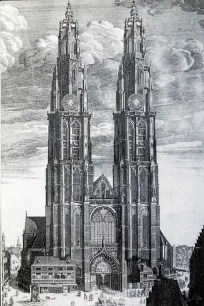
History
Early History
As early as in the 9th or 10th century a chapel was built where the current cathedral now stands, just south of the main market square. In 1132, eight years after the founding of a new parish dedicated to the Virgin Mary, a Romanesque church was built on the site of the old Carolingian chapel. This church was continuously expanded during the 13th and 14th centuries, and after the start of the construction of the cathedral it was gradually dismantled. In 1485, the towers, the last vestiges of the Romanesque church, were torn down.
Construction
In 1352 work started on plans to convert the existing church into the largest Gothic church in the low countries. Construction started with the choir on the east side and ended with the towers on the west side. The plans were constantly changed and became more and more ambitious as time went on. The original plans called for a nave with five bays but between 1454 and 1469 this was expanded to seven bays and later the transept was expanded with another bay as well. In 1521, 170 years after the first stone was laid, the church was finally ready for use. Meanwhile, completion of the south tower was put on hold.
Rising ambitions
But the ambition and aspirations of the city were growing during what was the start of its Golden Age, and starting in 1500 plans were made to build a much larger church: the choir would even be quadrupled in size! In 1521, the same year the church was completed following the original plans, the first stone of this new church – which would have been the largest building on earth – was laid by Holy Roman Emperor Charles V. This megalomaniac project, known simply as ‘New Work’, never came to fruition due to a decrease in funding, as well as a disastrous fire in 1533 which destroyed the ceiling and furniture and caused significant flood damage. By then only the foundations were finished. You can still see the contours of this ‘New Church’ in the street plan on satellite images.
Iconoclastic furies

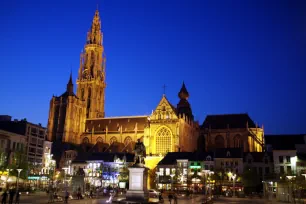
In 1559 a new bishopric was created for Antwerp, which promoted the church to the status of cathedral. The cathedral’s interior was completely ravaged and pillaged during the iconoclastic fury of 1566. Stained-glass windows, statues, monumental graves and relics were all destroyed by Calvinists. This was followed in 1578 by a period of Calvinist repression during which the walls, which used to be decorated with colorful murals, were whitewashed and the altars destroyed.
French occupation
The fall of Antwerp in 1585 led to the Contra-Reformation, during which the church was redecorated in the Baroque style. In 1610-1614 the wooden vaulting of the nave was rebuilt in stone.
The cathedral then went through another dark period, starting in 1794, under French occupation, when its artwork was looted by French troops and it was even used as a horse riding school. In 1801 the building lost its title as a cathedral but plans to demolish it were fortunately thwarted by the city architect Jan Blom. The church was reconsecrated in 1802 but wouldn’t regain its title as a cathedral until 1961.
Restoration
In the late 19th century the building was restored and some alterations were made following the original design. The transept was modified in the Neo-Gothic style and many of the sculptures on the portals date from this period. Restoration works continued until 1986.
Architecture
Despite the 170-year-long construction period, the architecture of the church is remarkably consistent in a Brabantian Late Gothic type of architecture that is known as the Flamboyant style. This style is characterized by its ornate and intricate decorations. Napoleon even compared the intricately decorated spire with bobbin lace.
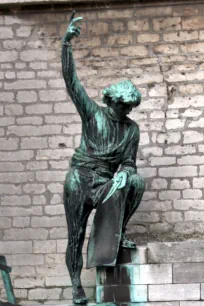
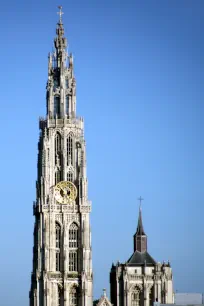
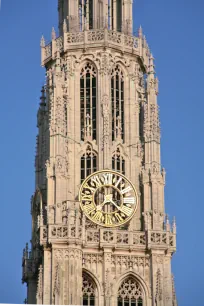
The architects
The cathedral was built by a long list of architects, starting with Jan Appelmans and Jacob van Tienen, who were in charge of the construction of the choir. They were succeeded by Pieter Appelmans, who, together with his father Jan, is now credited as the main architect of the cathedral. In 1906-1914 local sculptor Jef Lambeaux built a monument in their honor. You can find it on the right side of the main portal, against the base of the south tower.
They in turn were succeeded by master builder Jan Tac, who in 1439 was succeeded by Everaert Spoorwater, a successful architect who also worked on several other churches in the Netherlands, including the Grote Kerk (Great Church) in Dordrecht. After his death in 1473 construction was supervised by Herman de Waghemakere (designer of the St.James’s Church), who, in 1503, was succeeded by his son Domien de Waghemakere (who designed the Handelsbeurs). He completed the cathedral in 1521.
Dimensions
Even today, the dimensions of the cathedral are impressive. Due to height restrictions it is still – more than 500 years after its construction – the tallest building in the city. It is also the tallest Gothic church in the Low Countries.
The floorplan shows a cross-shaped design with a length of 117 meters and a width of 65 meters at its widest point (384 x 213 ft.), which allows space for 25000 people even though the official seating capacity is 2400. The main nave features seven aisles divided by thirty pillars that support the cross-ribbed vaults.
The towers
Since construction started with the choir on the east side the west towers were built last. The west front was built between 1422 and 1474.
The foundations for the north tower were laid in 1419 and by 1501 the base part of the tower was completed. The octagonal part of the tower, designed by Herman de Waghemakere, was built in 1507. The tower was finally complete in 1518 when his son Domien de Waghemakere realized its magnificent spire, which, even today, reigns over the city with a height of 123 meters (404 feet). The ornaments on the spire become more and more elaborate and detailed the closer the spire is to the sky.
The cathedral has a carillon with forty-seven bells, the largest of which is known as Karolus. It was cast in 1507 and weighs 6,434 kilograms (over 14,000 pounds). The bell was dedicated to the later Emperor of the Holy Roman Empire Charles V, who was only seven years old at the time.
The foundations for the south tower were placed together with those of the nave, in 1430. Construction of the tower was halted in 1475 when it was covered with a temporary wooden shale roof. The intention was to complete the tower later, but the fire of 1533 and the rise of Calvinism eventually meant that the plans were shelved, leaving its height at just 65.3 meters (214 feet).
Main portal

The main, west facade was built between 1458 and 1492. The sculpted decorations we see today are much more recent: until the 18th century the main portal was decorated with colorful paintings. They were replaced at the end of the 19th century by sculptures. The tympanum was completed as recently as 1903 and depicts the «Last Judgment».
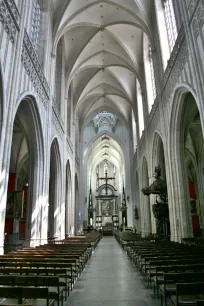

Interior
There are almost no traces left of the original Gothic interior. During its long lifespan, the cathedral has been looted twice: first during the iconoclasm, when the interior was completely destroyed, and again during the French occupation, when all furniture and artwork was looted or sold off. Some of it has been returned but several of today’s most important works inside the cathedral come from abbeys and churches that had been demolished or dissolved during the French occupation.
The first impression when entering the cathedral is that of a vast area forested with tall pillars. The main nave alone features 48 massive pillars. The nave is sparsely decorated and is mostly a hall that you walk through on your way to the choir.
Paintings
Despite all the plundering there are some major works of art inside the cathedral, not in the least the four canvases painted by master artist Peter Paul Rubens.
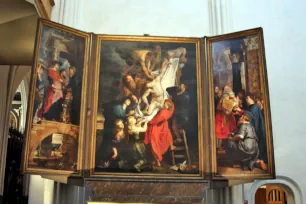

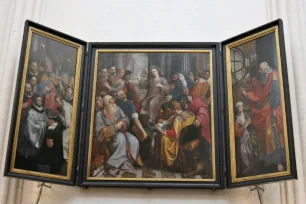
The most famous of those four is «Descent from the Cross», the central panel of a triptych which was painted by Rubens in 1612-1614. The triptych, which hangs in the south transept, is considered one of his masterpieces. This is one of the paintings that were removed in 1794 by French occupying forces and sent to the Louvre. It was returned in 1815 after Napoleon’s defeat.
Another large Rubens painting, «Raising of the Cross», can be admired in a similar spot opposite the crossing. It covers the same theme and was painted in 1610-1611. It is part of a large triptych that was originally placed in the historic Church of St. Walburga, which was closed in 1798 by the French government and later demolished. The triptych moved to the Louvre but was later returned to Antwerp and placed in the cathedral.
Besides two more Rubens paintings – the main altarpiece «Assumption of the Virgin» (1626) and the «Moretustriptych» (1612) in the chapel of Our Lady of Peace in the south ambulatory – there are many more paintings from lesser known artists. Some of the more interesting ones include «Assumption of the Virgin» (1647) by Cornelis Schut in the crossing and «Christ among the Scribes», a masterpiece from 1587 by Frans Francken the Elder that hangs in the north transept. The latter shows a theme from the Counter-Reformation in which a twelve-year-old Jesus lectures scribes in a temple. Two of these are thought to represent Luther and Calvin: Jesus re-educates them to put them back on the right track.
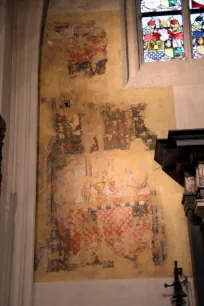
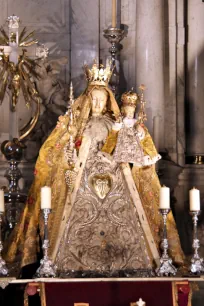
Even though most of the walls are now painted white you can still get a glimpse of what they must have looked like when the church first opened its doors in 1521 thanks to reconstructed sections of the original wall paintings that can be found all around the cathedral. Near the entrance of the sacristy you can see one such polychrome wall painting that was rediscovered during restorations. It was created at the end of the fifteenth century and is thought to be the oldest of these murals. It depicts the «Man of Sorrows» (The risen Christ) standing on an altar table with a chalice and host. Only the hand and head of Christ are visible today.
Sculptures
You can also find several interesting sculptures in the cathedral. The oldest one is a marble statue from around 1350 that depicts «Madonna and Child». It is attributed to an anonymous artist who worked in Liège. It was not part of the original patrimony; it was a donation received in 1866.
The Lady Chapel in the north aisle features a statue known as the «Lady of Antwerp», an almost life-size walnut statue of Mary. It is one of the very few works of art in the church that predates the iconoclasm of 1566. It was severely damaged but later restored and it survived the French occupation only because it was hidden in the cellar of a private citizen.
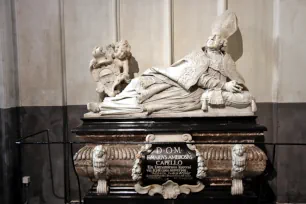
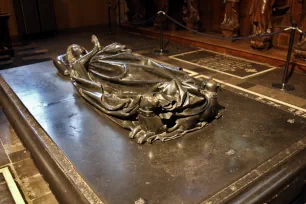
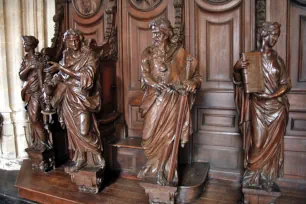
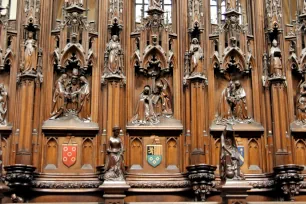
Funerary monuments were built in the cathedral for five of the seven first bishops of Antwerp. All but one were destroyed by French occupiers. The one tomb they did not destroy was sent to Paris but returned to the cathedral after the Napoleonic Wars. It can now be found at the entrance of the sacristy. The statue was created in 1676 by Artus Quellinus the Younger who was influenced by Bernini. It depicts Bishop Capello in a lying position with at his feet a putti holding a shield.
But the most important funerary monument in the cathedral is that of Isabella of Bourbon, wife of Charles the Bold. After her death in 1465 she was buried in the St. Michael’s Abbey in Antwerp. Her daughter had a large black funerary monument created for her that consisted of an effigy of Isabella resting on a sarcophagus surrounded by 24 bronze statues of weepers. The abbey was closed during the French occupation and later demolished. The monument was then broken up and a large part is now lost. In 1872 the effigy was installed in the Antwerp cathedral and in 1951 it was discovered that ten statues in the Rijksmuseum in Amsterdam that were thought to be Dutch noblemen, were actually weepers of Isabella’s tomb. Another weeper is in Warsaw, Poland. Isabella’s remains however are still lost.
You can also admire some beautiful wood sculptures, both in the choir and in the north aisle, where oak paneling with six confessionals decorates the walls. The confessionals were originally made in 1713 in a High Baroque style by Willem Kerricx and Michiel Van der Voort the Elder for the Cistercian abbey of St. Bernard. During the French Revolution, the abbey was shut down and its church demolished so its artwork was distributed to other churches. The statues on the confessionals represent the twelve apostles with twelve female figures.
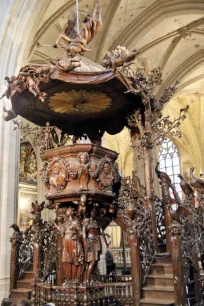
Choir and pulpit
More beautiful wood carvings can be admired in the choir. The Neo-Gothic choir stalls date from 1841-1883 and were designed by Frans-Andries Durlet. They are considered some of the most beautiful in the country. The central spires catch the eye but it’s the intricate carvings of numerous figures at the back of the stalls that are the most impressive. Thirty-six high-reliefs tell the story of Mary’s life, while others depict scenes from the bible.
The Late Baroque pulpit, which was – together with the confessionals – brought here from the abbey of St. Bernard – also features beautiful wood carvings. It is one of the masterpieces of Michiel Van der Voort the Elder, who created the pulpit in 1713. It is decorated with numerous sculptures and reliefs of birds (symbolizing Paradise), religious figures, and putti. At the top a trumpeting angel announces God’s message.


Altars
At its peak, before the Iconoclastic Furies, the church boasted 63 altars. Today, the aren’t quite as many, but there are still plenty of altars worth a closer look.
The high altar was built in 1822-1824 in the Neoclassical style using Baroque marble panels from the (now-demolished) Saint Walburgis Church. Its centerpiece is an almost five-meter-tall canvas by Peter Paul Rubens depicting the «Assumption of the Virgin». The predella below also comes from the Saint Walburgis Church and depicts Mozes showing a bronze snake.
The marble altar in the crossing of the cathedral is much more modern – it dates from 1993 – but it is decorated with a beautiful silver antependium that was ‘borrowed’ from the Shoemakers Chapel at the Shoemakers Market. It was created in 1865 by Jan Verschuylen and depicts the birth of Mary.
The altar of Saint-Anthony, on the north side of the ambulatory, features a statue of Saint-Anthony of Padua that was created in the second half of the seventeenth century by Artus II Quellinus.
The Chapel of the Holy Sacrament, on the south side of the cathedral, features the «Road to Emmaus appearance», an altarpiece painted in 1808 by Willem Jacob Herreyns. Above the painting are large sculptures with at the center God sitting on a globe decorated with a gilded representation of the zodiac. Allegorical statues on either side represent Faith and Hope.
Another interesting altar can be found in the Lady Chapel. It was reassembled in 1886 from the original panels created in 1687 by Artus Quellin the Younger and Pieter Verbrugghen. They depict scenes in the life of Mary. Particularly impressive is the altar table, which is partially obscured by the statue of the «The Lady of Antwerp».
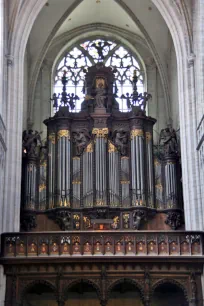
Organs
There are two large pipe organs in the cathedral. The most impressive of these two is the Schyven Organ in the narthex. It measures 14.4 meters in height and 10.5 meters in width (47 x 34 feet). The casing dates back to 1657 and was designed by Erasmus Quellin the Younger. The sculptures depicting St. Cecilia and angels on the casing were made by Pieter Verbrugghen. In 1891 Pieter Schyven built a completely new organ with 5,770 pipes behind the Baroque casing. This organ is suited for music from the nineteenth century.
For classical music a new organ was placed near the west end of the choir. This instrument is very recent and was built by the Swiss Metzler company. It is particularly suited for works by Johann Sebastian Bach.
Handschoenmarkt
The cathedral dominates the handschoenmarkt (gloves market), a triangular square that looks almost comically small compared to the towering building.
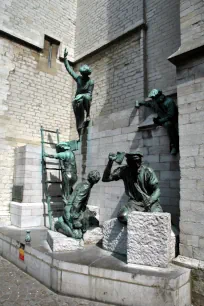

Monument to the builders of the cathedral
Despite its minute size, there are still three sights of note. The first one, set against the wall of the unfinished south tower is the aforementioned monument honoring Pieter Appelmans, one of the first architects of the cathedral. It was created in 1906-1914 by Jef Lambaux, who is best known for his nearby Brabo Fountain. The monument, which was inaugurated in 1935, shows the bronze figure of Pieter Appelmans with a plan of the cathedral on his knee, directing the craftsmen working on the cathedral.
The well of Quentin Matsys
Quentin Matsys, who lived from 1466 to 1530, is best known as a painter but he also designed the ironwork that crowns the well on the handschoenmarkt. The ironwork is topped with a small statue of Silvius Brabo, the protagonist of a legend that was the inspiration behind the Brabo Fountain. Matsys is also the subject of legend. An inscription on the well refers to this legend. It reads: “This ironwork was forged by Quinten Matsys. Love made the blacksmith a painter”.
According to the legend, Matsys had fallen in love with Catherina Heyns, the daughter of a painter. The father of Catharina objected to their marriage since he thought that a blacksmith was not good enough for his daughter. So Matsys retrained himself as a painter and painted a small fly on a canvas in the workshop of Catharina’s father while he was out. When the father returned to his workshop he thought it was a real fly and tried to swat it away. After discovering Matsys painted the life-like fly he gave his blessing to the marriage. A less captivating explanation for the change in profession is that a sickness had rendered Matsys too weak to continue as a blacksmith.

Nello & Patrasche
In the middle of the square is a statue of a boy and dog lying in eternal rest under a blanket of cobblestones. It was created in 2016 by the Belgian artist Batist Vermeulen and depicts the two main characters in a tragic fictional story that is set in Antwerp. The story comes from the novel ‘A dog of Flanders’ and was written in 1872 by the English author Ouida. The story is mostly unknown by locals but became particularly popular in Japan, where it was turned into an animation.
- Next: Grote Markt
- More Sights & Attractions in Antwerp
